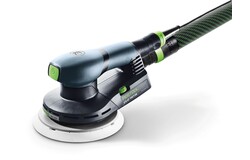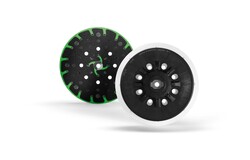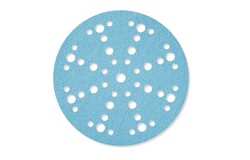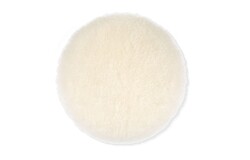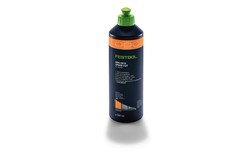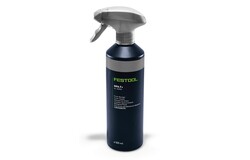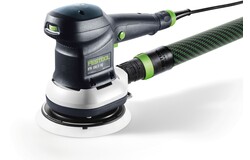High-gloss polishing of wooden surfaces

Description
Tools/accessories
Alternative tools
Procedure
-
Light sanding
Depending on the paint manufacturer, different work steps may be required to obtain a perfect surface. The following steps are suitable for most surfaces, to polish paint to a high-gloss finish.
Surface sanding with Festool ETS 150/3 and Granat paper in combination with the soft pad or, alternatively, the hard pad.
Affix the Granat P1500 Stickfix sanding disc to the ETS EC 150/3 EQ-Plus.
Tip: If there are significant irregularities and surface faults in the wood, you can begin surface sanding with the Granat P 800 and P 1200 sanding discs. This makes the process significantly shorter. If there are dust inclusions, these should be removed with a self-adhesive sanding disc or with a spot repair scraper before surface sanding.
-
Lightly spray the abrasive paper and surface with the finish cleaner.

-
Set the speed on the ETS 150/3 to level 3–4. Now move the machine over the wood cross-wise without applying pressure and with slow movements. Then wipe the remaining sanding dust from the surface with the grey polishing cloth after sanding. Continue sanding until the wood appears even and without significant differences in the level of gloss.

-
Polishing
Affix sheepskin to the RAP 150-21 rotary polisher.
Apply an appropriate amount of MPA 5010 polishing agent to the sheepskin.
With the deactivated RAP 150-21 rotary polisher and the sheepskin, distributed the polish evenly to the wooden surface.
Start up rotary polisher RAP 150-21 at speed 1 and distribute the polishing agent.
While the machine is running, set the speed to level 3–4.
Guide the machine rapidly over the surface, otherwise there is a risk of excessive heating of the surface.
Wipe the surface several times with the coarse side of the green polishing cloth and inspect. If necessary, repeat the described process. There should be no visible traces of sanding.
-
For most applications, the achieved result is very good and usually adequate. If working with very sensitive colours (black and very strong colours), however, it can be necessary to continue polishing in order to achieve the desired degree of gloss.

-
Affix the blue, fine, waffle-face sponge to the RAP 150-21 rotary polisher.
Apply an appropriate amount of MPA 9010 polishing agent to the polishing sponge.
With the deactivated RAP 150-21 rotary polisher and the fine sponge, distribute the polish evenly over the surface.
Start up rotary polisher RAP 150-21 at speed 1 and distribute the polishing agent.
While the machine is running, set the speed to level 3–4.
Move the machine over the surface with even movements.
Wipe the surface several times with the finer side of the green polishing cloth and inspect. If necessary, repeat the described process.
Tip: Wash the microfibre cloth thoroughly under running water after each change of polish.
-
Our illustrated guides and work results are documented working steps that we have performed in practice. They are individual examples and do not guarantee or promise that users will obtain the same results. The results will depend on the user's experience and skill, as well as the material being used. Illustrated guides do not replace any Festool operating manuals and/or safety instructions. Liability for ensuring that the information, instructions and applications are free from content defects and defects of title, in particular with regard to the absence of defects, correctness, freedom from third party intellectual property rights and copyrights, completeness and fitness for purpose, is excluded. Claims for damages made by the user, regardless of their legal basis, are excluded. These liability exclusions are not applicable if the damage was intentional or caused by gross negligence, or in cases of statutory liability.
We cannot accept liability for damage resulting from defects.↑


